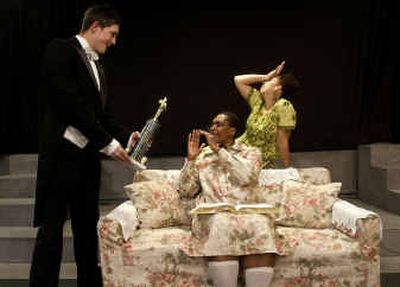Impact

“The Colored Museum,” George C. Wolfe’s satirical revue about black history and culture, hit the New York theater scene in 1986 like a comic grenade.
New York Times theater critic Frank Rich said it left the audience “in ruins.” The words “devastated” and “demolished” were also bandied about. By the way – he loved it.
So, is this a good choice for the Spokane Civic Theatre’s annual collaboration with the Onyx Theatre Troupe?
“It’s a perfect fit, especially for the (smaller) Studio Theatre space,” said director Bryan Jackson, an English teacher at Lewis and Clark High School. “For so long, many of the African American plays were bitter; either that, or they were straight-out comedies. But with the coming of ‘The Colored Museum,’ here we had a piece that dealt with the bitter issues but allowed the humor to come out, and allowed people to laugh at these things. Once we can laugh at things, it changes our psyches.”
“The Colored Museum” has long been acknowledged as a milestone in African American theater. This revue targets many of the sacred cows of African American culture, including the beloved 1959 Broadway play, “A Raisin in the Sun,” here parodied as “The Last Mama-On-The-Couch Play.”
You might compare this show’s impact to that of Spike Lee’s movies in the 1980s. They were controversial at times and illusion-shattering, but they ushered in a new era of powerful artistic expression.
Wolfe, relatively unknown at the time, went on to direct two smash musicals, “Jelly’s Last Jam” and “Bring in ‘da Noise, Bring in ‘da Funk,” and the most acclaimed play of the 1990s, “Angels in America.”
The play is structured as a series of comedy vignettes, with the conceit that they are a series of exhibits at a black history museum. Rich called it “black black humor.”
Just to give you some idea of the irreverent tone of “The Colored Museum,” consider this: One sketch features a perky stewardess who welcomes everyone aboard to a “celebrity slaveship” bound for Savannah. The sign overhead says, “Fasten Shackles.”
“It’s a piece that explores both the foibles and hang-ups of both African American and the dominant Anglo culture,” said Jackson. “If people can get past the comedy and see what it is that they are really alluding to, I think the impact will be tremendous.”
The show contains some music, but is not by any stretch a musical. The music is used to accent the vignettes.
The show is usually performed with a five-person cast, but Jackson has assembled a 12-person cast. The cast includes a number of veterans of the Onyx and Civic stages, including A’Dell McAlpine-Whitehead and Ms. Inez , as well as a number of first-timers. Some roles originally written for men will be played by women in this version, because Jackson said he ran into the issue of finding enough African-American male actors. Other cast members include Shivara Allen, Dorothy Davis, Caleah Griffin, Tia Patrice Griffin, Nicole Hicks-Wedge, Alyssa Jordan, Symira Smith, Rhonda Stainrod, Kirk Wayne and Zebulon Zilar.
The Onyx Theatre Troupe is Spokane’s African-American theater group.